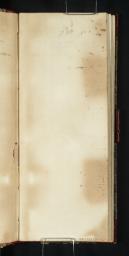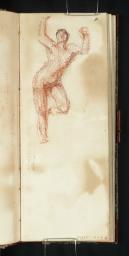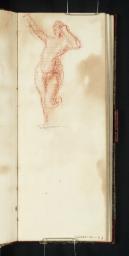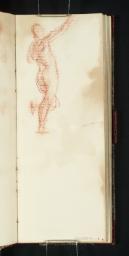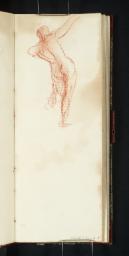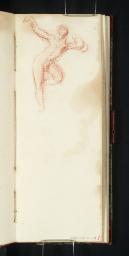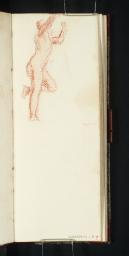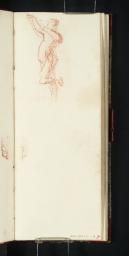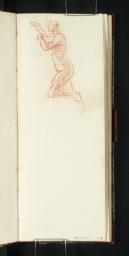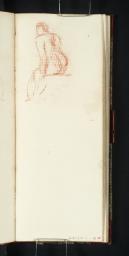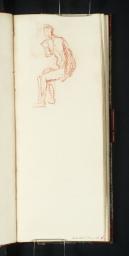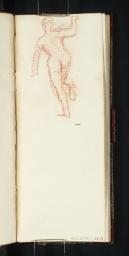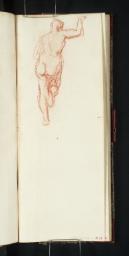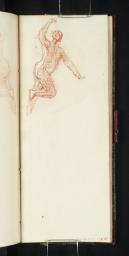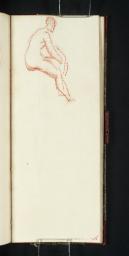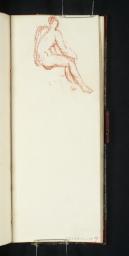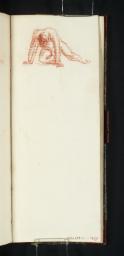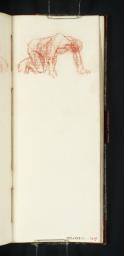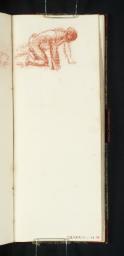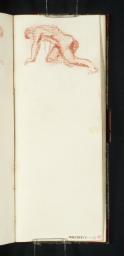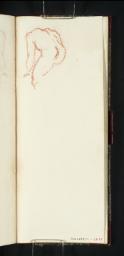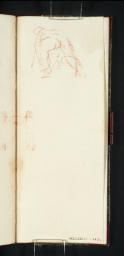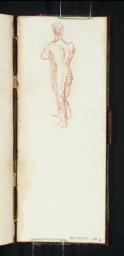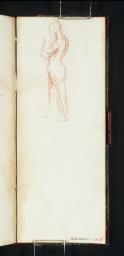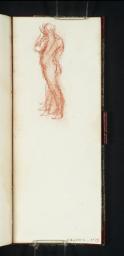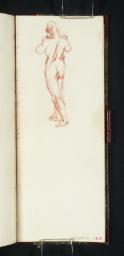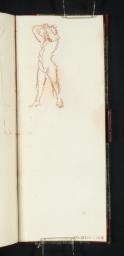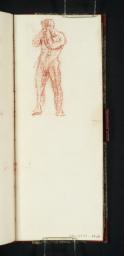Turner Bequest CCLXXIXb 1–37
Sketchbook bound in boards, quarter bound in grey and crimson marbled paper with crimson leather spine, three crimson leather loops, and a document pocket in the inside back cover lined in marbled paper
37 leaves of white laid paper
Numbered 262 as part of the Turner Schedule in 1854 and endorsed by the Executors of the Turner Bequest in ink and pencil on inside front cover (see technical notes)
37 leaves of white laid paper
Numbered 262 as part of the Turner Schedule in 1854 and endorsed by the Executors of the Turner Bequest in ink and pencil on inside front cover (see technical notes)
Accepted by the nation as part of the Turner Bequest 1856
References
This thin, narrow pocketbook contains 32 academic nudes rapidly sketched in red chalk.1 As the art historian Ian Warrell has pointed out, Turner particularly favoured sketchbooks of this ‘almanac’ format in the later years of the 1830s, leading to its present dating.2 Some of these sketches feature pencil under-drawings although most are made up only of strokes of chalk, thickly applied so as to reveal the fine corrugations of the laid paper support. Throughout the sketchbook counterproofs of the nudes are consistently impressed onto facing pages where it has been closed and subjected to pressure. Another distinctive feature of this volume is the consistent placement of the figures in the top half of the page, often very close to the uppermost edge.
This item regularly appears in Turner scholarship in connection to his erotic sketches, mainly because John Ruskin bundled it with other volumes featuring such material and preserved it ‘as evidence of the failure of mind only’.3 However, ever since A.J. Finberg compiled his 1909 inventory of the Bequest, it has been more appropriately linked with the practices of the life-drawing studio. The Royal Academy of Arts provided regular opportunities for drawing from the male and female nude model, first at its premises in Somerset House and, from 1837, in the east wing of the National Gallery building in Trafalgar Square.4 These were aimed primarily at providing students with a curriculum in classical drawing technique although senior Academicians were also known to make use of the facility.5 Turner was one of these life-long dedicatees to the life-drawing class; indeed, the correspondence still refers to such sessions (and their physical discomforts) when he was well into his seventh decade.6 The Bequest comprises a substantial body of works associated with this aspect of Turner’s practice, the earliest of which date from his student days. For an example of Turner’s early essays in the highly finished conventions of the heroic nude study (large format, black chalk, white heightening), see D00202 (Turner Bequest XVIII G). Later pieces in the collection show a willingness to experiment with a range of media – including watercolour – and a greater fluency of manner; see, for instance, D01822 (Turner Bequest XLIII 6), D05209 (Turner Bequest LXXXIV 36), D10422 (Turner Bequest CXL 7). The nude studies in the Life Class (1) sketchbook, such as D27455 (Turner Bequest CCLXXIX 50a), are particularly close in style to those in the present volume.
The dating of these studies to the 1830s is of note because this period was the peak of Turner’s activity as a teacher in the Academy’s life drawing classes. Over the course of that decade he held the official post of drawing instructor (Annual Visitor) in 1830, 1831, 1834, 1835, and 1837.7 Later nineteenth-century anecdotes present Turner as an innovative presence in the Life Academy, posing the model alongside an antique statue or erecting a white backcloth so as to ‘infuse new life into the practice of his students’.8 We might speculate that some of the distinctive aspects of this sketchbook derive from these didactic activities in the life class rather than from the development of personal ideas and projects. Many of these sketches form suites of studies of the same pose drawn from different angles on consecutive pages, perhaps as he worked his way around the horse-shoe arrangement of the students’ desks clarifying or demonstrating some point of pose or tone to his charges; see, for example, folios 3 recto to 8 recto (D27483–D27488; Turner Bequest CCLXXIXb 3- CCLXXIXb 8). The consistent placement of the nudes at the very top of the page is suggestive of the practice of the ‘sight-size’ drawing technique, or perhaps its demonstration. In this method, the artist attempts to capture the exact size and proportion of the subject by holding up his drawing against the field of vision, aligning the actual object and its representation as closely as possible. Hence, it is proposed, the drawings’ close proximity to the top edge of the page, as the artist – holding the volume vertically as he worked – sought a direct and continuous comparison between the model and his sketch.
For all the reputed innovation of Turner’s approach to the life drawing class, the heroic poses caught here are conventional to academic practice. For instance, the raised arms and legs of the figures on folios 3 recto and 15 recto (D27483, D27495; Turner Bequest CCLXXIXb 3, CCLXXIXb 15) are suggestive energetic action or the generic expression of awe at some sublime event or object. By contrast, the seated figure on folio 16 recto (D27496; Turner Bequest CCLXXIXb 16) is presented in perfect classical repose. On folio 18 recto (D27498; Turner Bequest CLXXIXb 18) the figure appears floored by a fatal wound while the hands-to-face posture caught on folio 30 recto (D27510; Turner Bequest CCLXXIXb 30) is redolent of tragic suffering.
Gerald Wilkinson thought these sketches too ‘dull’ to be by Turner, although he is the only writer on this material to question its attribution; see Gerald Wilkinson, Turner’s Colour Sketches 1820–34, London 1975, p.71.
Ian Warrell, ‘Exploring the “Dark Side”: Ruskin and the Problem of Turner’s Erotica’, with ‘A Checklist of Erotic Sketches in the Turner Bequest’, British Art Journal, vol.4, no.1, Spring 2003, p.41.
A.J. Finberg, A Complete Inventory of the Drawings of the Turner Bequest, London 1909, vol.II, p.890.
Ann Chumbley and Ian Warrell, Turner and the Human Figure: Studies of Contemporary Life, exhibition catalogue, Tate Gallery, London 1989, pp. 12–16.
Technical notes
How to cite
John Chu, ‘Life Class (2) sketchbook ?1835–40’, sketchbook, February 2015, in David Blayney Brown (ed.), J.M.W. Turner: Sketchbooks, Drawings and Watercolours, Tate Research Publication, August 2016, https://www

